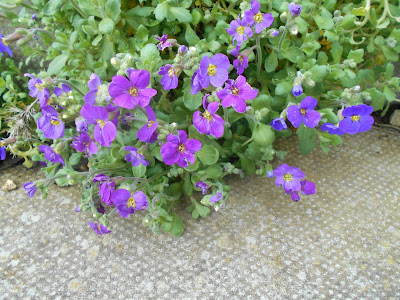 |
Common Whitlowgrass edging Christchurch Road, Daventry.
8 March, 2020
|
In fact, once again, they turned out to be Common Whitlowgrass, a plant I discussed only a few days ago ('In Darkest Daventry', 3 March). Disappointing, though no doubt we will all be seeing Danish Scurvy Grass in profusion before long. It often has a hint of purple-pink to its petals, in which case it is quite distinctive. Incidentally I have in the past 24 hours found that Captain James Cook recommended the use of Scurvy Grass on board ship. We now know that it has a high Vitamin C content.
Another edging plant par excellence is currently flowering in our garden - and thousands of others up and down the country. I refer of course to the Aubretia, Aubrieta deltoides. I am always pleased to see it because its blooming often coincides with the first appearance of the Dark-edged Bee Fly, Bombylius major, an insect which commonly visits aubretia, together with flowers such as primroses, celandines and violets. It often provokes comments such as, 'What are the bees with long pointy heads which hover in front of flowers taking nectar?' Certainly these insects are very bee-like superficially but are not really related, bees having four wing but bee-flies only two.
 |
Aubretia, Aubrieta deltoides, in our front garden,
8 March, 2020
|
I'll be monitoring bee-flies with particular care this year because the Dotted Bee-fly, B. discolor, has recently been noted in Northamptonshire and may be increasing its range.
Speaking of crucifers I am watching with interest a plant of Woad, Isatis tinctoria, which was kindly bought for me by my friend Lynda. It is still some weeks short of flowering but be warned: I intend to do a blog on it at the appropriate time. Once mature I'll be painting myself with its blue dye and prancing through Daventry (by 'mature' I refer to the plant, obviously not me).
No comments:
Post a Comment